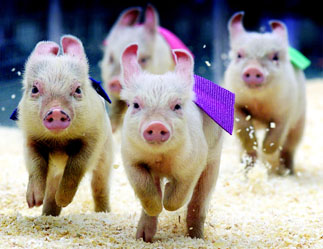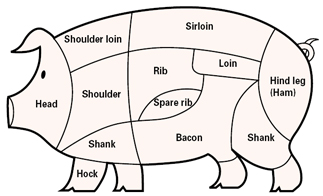A good year to eat porcine products

For example, Korean and Chinese diners enjoy pork immensely. In fact pork accounts for over half of Korea’s meat consumption. In Korea, annual meat consumption per person is 33 kilograms (72 pounds), of which pork consumption is 18 kilograms while chicken and beef are 8 kilograms and 7 kilograms respectively.
On the other hand, pork is taboo in Islamic and Jewish cultures. It is largely for religious reasons, but the hot climates where those cultures thrive quicken the deterioration of meat and cause food poisoning may have also been a factor. For Koreans, there are many ways to consume pork as we salute “the Year of the Golden Pig.”
Professor Ju Seon-tae of Gyeongsang National University, Lee Wi-hyeong of the Meat Business Consulting Center, Professor Bae Yeong-hui of Osan University and Professor Kim Jeong-in of Inje University have agreed to offer some advice.
Taste: The common classification is to label pork and beef as red meat, and chicken as white meat. There is a smaller amount of red muscle in pork than there is in beef. Since a higher percentage of red muscle means a tougher texture, pork is often more tender than beef. This is why Americans call pork “the other white meat.”
Pork owes its taste to its fat content. Korean-style bacon, which contains 28.4 grams (1 ounce) of fat per 100 grams of meat, is preferred to sirloin, which only has 8.8 grams of fat per 100 grams of meat. While Korean-style bacon melts in the mouth, the less fatty meat from the lower leg can be brittle and dry. Experts say if pork ribs served in restaurants are not soft and greasy, it’s likely that they are using the hind leg portion.
Vitamin B1 and proteins: These are the two main nutrients in pork. vitamin B1 content of pork is ten times that of beef. Vitamin B1 helps fuel the body by converting blood sugar into energy, and it also prevents skin from aging. The body especially needs vitamin B1 when combating illness, before and after surgery and when under stress. What’s more, vitamin B1 is the nutrient that Koreans are most likely to be deficient in, because there is none in rice.

Caution: The problem is that Koreans love grilled bacon; it accounts for as much as a quarter of domestic pork consumption. Korean-style bacon has the highest fat content and therefore excessive consumption should be avoided. It can cause obesity and various circulation-related problems such as high blood pressure, arterial sclerosis, heart disease and stroke. Afficionados could try eating the bacon in the British style, as a sandwich, between two pieces of multi-grain bread.
Experts recommend the parts of the pig that have a lower fat content, such as the loin. It is healthier to boil the meat rather than grilling or roasting it. The dietary habits of the people of Okinawa island, well-known for their longevity, are a good example. While they consume 95 grams of pork daily, an amount far exceeding the average consumption in Japan, the rate of stroke-related death is the lowest in Japan. This is because they eat boiled loin that is very low in fat.
Make sure the meat is well cooked to a temperature of over 75 degrees Centigrade.
A high temperature kills germs such as staphylococci or trichinae that cause food poisoning.
However, meat should never be overcooked or burned. If cooked at temperatures of over 150 degrees Centigrade, substances that cause cancer such as heterocyclicamin (HCA) are produced
A match made in heaven: Shiitake mushrooms, pickled shrimp, soybean curd, and buckwheat all go well with pork.
The fiber found in shiitake mushrooms stop the cholesterol in pork from being absorbed by the body. Pickled shrimp provide a delicious seasoning to the pork, and also help with digestion because they contain enzymes that dissolve proteins and fats. Lecithin in soybean curd eliminates cholesterol and clears blood vessels. In buckwheat there are capillary-strengthening bioflavonoids.
Pork Cuts and Their Uses
·Shoulder loin
Suitable for grilling. Adequate fat content makes this portion taste good.
·Picnic
Good for bulgogi (thinly sliced, marinated and grilled), stew or boiling.
·Ribs
Suitable for barbeque, bulgalbi or boiling. Refers to meat on the first five ribs. Adequate fat between the muscles gives this portion a good flavor.
·Bacon
For grilling. Mixture of muscle and fat gives this portion a good flavor.
·Hind leg (ham)
For frying, bulgogi, boiling in soy sauce. Relatively less fat.
·Tenderloin
For grilling or sweet and sour pork. Tender and soft in texture.
Source: Korea Swine Association
By Park Tae-kyun JoongAng Ilbo [jbiz91@joongang.co.kr]










with the Korea JoongAng Daily
To write comments, please log in to one of the accounts.
Standards Board Policy (0/250자)